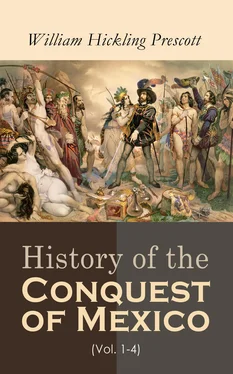After a period of four centuries, the Toltecs, who had extended their sway over the remotest borders of Anahuac, [23]having been greatly reduced, it is said, by famine, pestilence, and unsuccessful wars, disappeared from the land as silently and mysteriously as they had entered it. A few of them still lingered behind, but much the greater number, probably, spread over the region of Central America and the neighboring isles; and the traveller now speculates on the majestic ruins of Mitla and Palenque, as possibly the work of this extraordinary people. [24] [25]
After the lapse of another hundred years, a numerous and rude tribe, called the Chichimecs, entered the deserted country from the regions of the far Northwest. They were speedily followed by other races, of higher civilization, perhaps of the same family with the Toltecs, whose language they appear to have spoken. The most noted of these were the Aztecs or Mexicans, and the Acolhuans. The latter, better known in later times by the name of Tezcucans, from their capital, Tezcuco, [26]on the eastern border of the Mexican lake, were peculiarly fitted, by their comparatively mild religion and manners, for receiving the tincture of civilization which could be derived from the few Toltecs that still remained in the country. [27]This, in their turn, they communicated to the barbarous Chichimecs, a large portion of whom became amalgamated with the new settlers as one nation. [28]
Availing themselves of the strength derived, not only from this increase of numbers, but from their own superior refinement, the Acolhuans gradually stretched their empire over the ruder tribes in the north; while their capital was filled with a numerous population, busily employed in many of the more useful and even elegant arts of a civilized community. In this palmy state, they were suddenly assaulted by a warlike neighbor, the Tepanecs, their own kindred, and inhabitants of the same valley as themselves. Their provinces were overrun, their armies beaten, their king assassinated, and the flourishing city of Tezcuco became the prize of the victor. From this abject condition the uncommon abilities of the young prince, Nezahualcoyotl, the rightful heir to the crown, backed by the efficient aid of his Mexican allies, at length redeemed the state, and opened to it a new career of prosperity, even more brilliant than the former. [29]
The Mexicans, with whom our history is principally concerned, came also, as we have seen, from the remote regions of the North,—the populous hive of nations in the New World, as it has been in the Old. [30]They arrived on the borders of Anahuac towards the beginning of the thirteenth century, some time after the occupation of the land by the kindred races. For a long time they did not establish themselves in any permanent residence, but continued shifting their quarters to different parts of the Mexican Valley, enduring all the casualties and hardships of a migratory life. On one occasion they were enslaved by a more powerful tribe; but their ferocity soon made them formidable to their masters. [31]After a series of wanderings and adventures which need not shrink from comparison with the most extravagant legends of the heroic ages of antiquity, they at length halted on the southwestern borders of the principal lake, in the year 1325. They there beheld, perched on the stem of a prickly pear, which shot out from the crevice of a rock that was washed by the waves, a royal eagle of extraordinary size and beauty, with a serpent in his talons, and his broad wings opened to the rising sun. They hailed the auspicious omen, announced by an oracle as indicating the site of their future city, and laid its foundations by sinking piles into the shallows; for the low marshes were half buried under water. On these they erected their light fabrics of reeds and rushes, and sought a precarious subsistence from fishing, and from the wild fowl which frequented the waters, as well as from the cultivation of such simple vegetables as they could raise on their floating gardens. The place was called Tenochtitlan, in token of its miraculous origin, though only known to Europeans by its other name of Mexico, [32]derived from their war-god, Mexitli. [33]The legend of its foundation is still further commemorated by the device of the eagle and the cactus, which form the arms of the modern Mexican republic. Such were the humble beginnings of the Venice of the Western World. [34] [35]
The forlorn condition of the new settlers was made still worse by domestic feuds. A part of the citizens seceded from the main body, and formed a separate community on the neighboring marshes. Thus divided, it was long before they could aspire to the acquisition of territory on the main land. They gradually increased, however, in numbers, and strengthened themselves yet more by various improvements in their polity and military discipline, while they established a reputation for courage as well as cruelty in war which made their name terrible throughout the Valley. In the early part of the fifteenth century, nearly a hundred years from the foundation of the city, an event took place which created an entire revolution in the circumstances and, to some extent, in the character of the Aztecs. This was the subversion of the Tezcucan monarchy by the Tepanecs, already noticed. When the oppressive conduct of the victors had at length aroused a spirit of resistance, its prince, Nezahualcoyotl, succeeded, after incredible perils and escapes, in mustering such a force as, with the aid of the Mexicans, placed him on a level with his enemies. In two successive battles, these were defeated with great slaughter, their chief slain, and their territory, by one of those sudden reverses which characterize the wars of petty states, passed into the hands of the conquerors. It was awarded to Mexico, in return for its important services. [36]
Then was formed that remarkable league, which, indeed, has no parallel in history. It was agreed between the states of Mexico, Tezcuco, and the neighboring little kingdom of Tlacopan, that they should mutually support each other in their wars, offensive and defensive, and that in the distribution of the spoil one-fifth should be assigned to Tlacopan, and the remainder be divided, in what proportions is uncertain, between the other powers. The Tezcucan writers claim an equal share for their nation with the Aztecs. But this does not seem to be warranted by the immense increase of territory subsequently appropriated by the latter. And we may account for any advantage conceded to them by the treaty, on the supposition that, however inferior they may have been originally, they were, at the time of making it, in a more prosperous condition than their allies, broken and dispirited by long oppression. What is more extraordinary than the treaty itself, however, is the fidelity with which it was maintained. During a century of uninterrupted warfare that ensued, no instance occurred where the parties quarrelled over the division of the spoil, which so often makes shipwreck of similar confederacies among civilized states. [37]
The allies for some time found sufficient occupation for their arms in their own valley; but they soon overleaped its rocky ramparts, and by the middle of the fifteenth century, under the first Montezuma, had spread down the sides of the table-land to the borders of the Gulf of Mexico. Tenochtitlan, the Aztec capital, gave evidence of the public prosperity. Its frail tenements were supplanted by solid structures of stone and lime. Its population rapidly increased. Its old feuds were healed. The citizens who had seceded were again brought under a common government with the main body, and the quarter they occupied was permanently connected with the parent city; the dimensions of which, covering the same ground, were much larger than those of the modern capital of Mexico. [38] [39]
Fortunately, the throne was filled by a succession of able princes, who knew how to profit by their enlarged resources and by the martial enthusiasm of the nation. Year after year saw them return, loaded with the spoils of conquered cities, and with throngs of devoted captives, to their capital. No state was able long to resist the accumulated strength of the confederates. At the beginning of the sixteenth century, just before the arrival of the Spaniards, the Aztec dominion reached across the continent, from the Atlantic to the Pacific, and, under the bold and bloody Ahuitzotl, its arms had been carried far over the limits already noticed as defining its permanent territory, into the farthest corners of Guatemala and Nicaragua. This extent of empire, however limited in comparison with that of many other states, is truly wonderful, considering it as the acquisition of a people whose whole population and resources had so recently been comprised within the walls of their own petty city, and considering, moreover, that the conquered territory was thickly settled by various races, bred to arms like the Mexicans, and little inferior to them in social organization. The history of the Aztecs suggests some strong points of resemblance to that of the ancient Romans, not only in their military successes, but in the policy which led to them. [40]
Читать дальше












